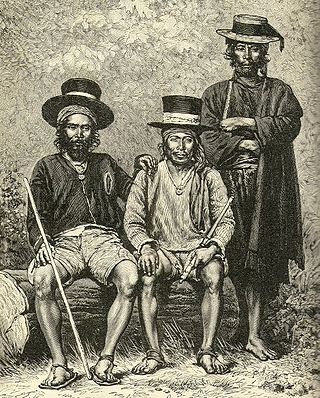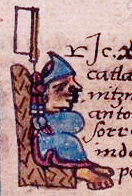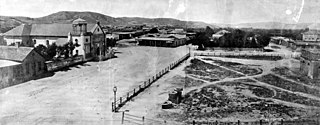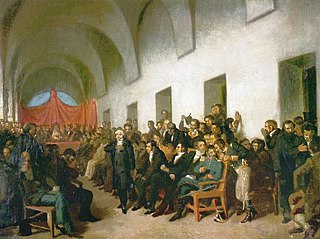
Alcalde is the traditional Spanish municipal magistrate, who had both judicial and administrative functions. An alcalde was, in the absence of a corregidor, the presiding officer of the Castilian cabildo and judge of first instance of a town. Alcaldes were elected annually, without the right to reelection for two or three years, by the regidores of the municipal council. The office of the alcalde was signified by a staff of office, which they were to take with them when doing their business. A woman who holds the office is termed an Alcaldesa.

Don Diego de Alvarado Huanitzin was a 16th-century Nahua noble. A grandson of Axayacatl, Nephew of tlatoani Moctezuma II. He was initially the tlatoani (ruler) of Ecatepec before becoming tlatoani of Tenochtitlan, as well as its first governor under the colonial Spanish system of government.

El Pueblo de Nuestra Señora la Reina de los Ángeles, shortened to Pueblo de los Ángeles, was the Spanish civilian pueblo settled in 1781, which became the American metropolis of Los Angeles. The pueblo was built using labor from the adjacent village of Yaanga and was totally dependent on local Indigenous labor for its survival.

Don Diego de San Francisco Tehuetzquititzin was the 16th tlatoani and second governor of Tenochtitlan.

Don Luis de Santa María Nanacacipactzin, also known as Cipac, was the last tlatoani ("king") of the Nahua altepetl of Tenochtitlan, as well as its governor (gobernador) under the colonial Spanish system of government. The previous ruler Cristóbal de Guzmán Cecetzin having died in 1562, Nanacacipactzin was installed on September 30, 1563, and ruled until his death on December 27, 1565.

The municipalities or municipios of El Salvador correspond to the second level administrative division in the Republic of El Salvador which divide its departments. El Salvador contains 262 municipalities.

A cabildo or ayuntamiento was a Spanish colonial and early postcolonial administrative council that governed a municipality. Cabildos were sometimes appointed, sometimes elected, but were considered to be representative of all land-owning heads of household (vecinos). The colonial cabildo was essentially the same as the one that was developed in medieval Castile.
Don Juan de Guzmán Itztolinqui was a post-Conquest tlatoani (ruler) of the altepetl of Coyoacán in the Valley of Mexico.
Don Juan de Santo Domingo de Mendoza Tlacaeleltzin Chichimeca teuctli was the tlatoani (ruler) of Itztlacozauhcan in Amaquemecan, Chalco from 1548 to 1563.

Antonio Valeriano was a colonial Mexican, Nahua scholar and politician. He was a collaborator with fray Bernardino de Sahagún in the creation of the twelve-volume General History of the Things of New Spain, the Florentine Codex, He served as judge-governor of both his home, Azcapotzalco, and of Tenochtitlan, in Spanish colonial New Spain.

Don Cristóbal de Guzmán Cecetzin was a colonial Nahua noble from Santa María Cuepopan in San Juan Tenochtitlan. A son of the ruler don Diego Huanitzin, don Cristóbal first served as alcalde in 1556 before becoming Tenochtitlan's next-to-last tlatoani and third governor in 1557, titles he held until his death in 1562.
Don Antonio Valeriano, the younger was a colonial Mexican Nahua politician.
The Royal Governor of Panama ruled over the Spanish colonial administrative district known first as the colony of Darién and later as the colony of Castilla de Oro, which in 1529 was renamed Panamá. This district was subordinated to the Viceroyalty of New Granada on August 20, 1739. There were 113 such governors or presidents during the Spanish conquest and the later periods of Spanish-centered colonialism.

The mayor of Valenzuela, a highly urbanized city in northern Metro Manila, Philippines, is the official head and chief executive of Valenzuela. He leads on enforcing city ordinances and improving public services. The mayor has a term of office of three years, but has a maximum electoral tenure of three consecutive terms. Inaugural holder of the office was Pío Valenzuela (1869–1956), served from 1899 to 1901, whom the city received its name.
Juan Leal Goraz, also called Juan Leal Gonzal, was a Spanish settler and politician who served as the first alcalde of La Villa de San Fernando, which later would become the city of San Antonio, Texas. A native of the Canary Islands, Leal went to San Antonio in 1731 leading a group of settlers from the Canary Islands to populate this municipality, founded by the Spanish government under the sponsorship of King Philip V. Leal had asserted himself as the Canarian emigrants' leader and spokesman since they left the islands. He served as alcade of San Antonio between 1731 and 1732, and again in 1735.

Chimalpilli II was a Tlatoani (ruler) of the Nahua altepetl (city-state) Ecatepec, in 16th-century Mesoamerica.














